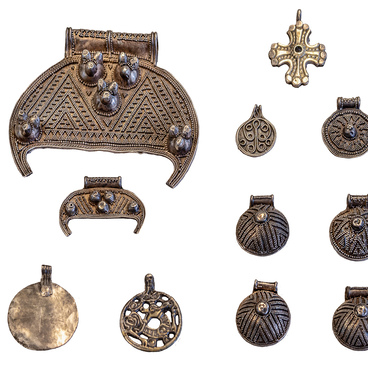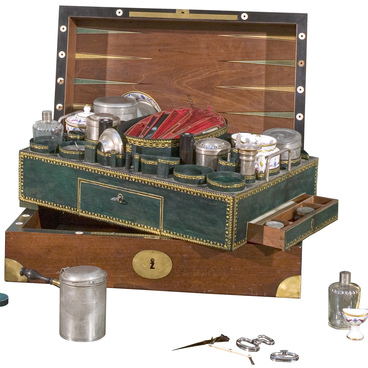The displayed architectural details in the shape of dragon heads were made in the 13th or 14th century. They adorned the palace of a medieval Mongol feudal lord, which was located on the territory of modern Chita Oblast, 10 kilometers from the village of Kondui. The architectural complex became known under the name “Konduisky gorodok” (“the town of Kondui”).
The first plan of the palace ruins was made in 1798; whereas in the scientific literature it was first mentioned in 1818. Excavations of the complex were conducted almost a century and a half later, in the late 1950s, and led by the famous Soviet archaeologist, researcher of ancient and medieval history of Siberia, Sergei Kiselev.
The palace complex was located on a high platform, which was decorated with two-tiered verandas. They were surrounded by wooden balustrades covered with red varnish. Granite statues of mythical monsters reminiscent of dragons were also located on the lower terrace.
The two-tier Chinese-style roof was supported by more than 50 columns. The roof was decorated with sculptural images: on the edges — carved drains for rainwater, and on the crests of the roof — the heads of winged dragons. They were turned to face each other, and, in a way, held the ends of the ridge beam in their mouths. Similar images, but of a smaller size, were located at the joints of the roof.
Archaeologists have discovered many other statues on the territory of the palace complex: phoenixes, chimeras, statues of people dressed in Buddhist robes, as well as four more dragon sculptures. Three of them were shaped like heads of mythical monsters; the fourth one was the front part of the dragon, which rests on its front paws.
On the inside, the palace was divided into three spacious halls with tall columns. The walls were decorated with frescoes. The roof had patterned tiles. During the excavations, archaeologists found its fragments with traces of yellow and red glaze. Up until the 18th century, only members of the Genghisid dynasty were allowed to use such colors. Thus, scientists have suggested that the palace belonged to one of Genghis Khan’s descendants — perhaps his nephew Isunka.
At the end of the 14th century, the “Konduisky gorodok” burned down. And in 1806, residents of the village of Kondui used some parts of the ancient ruins to build a church. Statues of dragons were immured in the walls around the perimeter of the church.
The first plan of the palace ruins was made in 1798; whereas in the scientific literature it was first mentioned in 1818. Excavations of the complex were conducted almost a century and a half later, in the late 1950s, and led by the famous Soviet archaeologist, researcher of ancient and medieval history of Siberia, Sergei Kiselev.
The palace complex was located on a high platform, which was decorated with two-tiered verandas. They were surrounded by wooden balustrades covered with red varnish. Granite statues of mythical monsters reminiscent of dragons were also located on the lower terrace.
The two-tier Chinese-style roof was supported by more than 50 columns. The roof was decorated with sculptural images: on the edges — carved drains for rainwater, and on the crests of the roof — the heads of winged dragons. They were turned to face each other, and, in a way, held the ends of the ridge beam in their mouths. Similar images, but of a smaller size, were located at the joints of the roof.
Archaeologists have discovered many other statues on the territory of the palace complex: phoenixes, chimeras, statues of people dressed in Buddhist robes, as well as four more dragon sculptures. Three of them were shaped like heads of mythical monsters; the fourth one was the front part of the dragon, which rests on its front paws.
On the inside, the palace was divided into three spacious halls with tall columns. The walls were decorated with frescoes. The roof had patterned tiles. During the excavations, archaeologists found its fragments with traces of yellow and red glaze. Up until the 18th century, only members of the Genghisid dynasty were allowed to use such colors. Thus, scientists have suggested that the palace belonged to one of Genghis Khan’s descendants — perhaps his nephew Isunka.
At the end of the 14th century, the “Konduisky gorodok” burned down. And in 1806, residents of the village of Kondui used some parts of the ancient ruins to build a church. Statues of dragons were immured in the walls around the perimeter of the church.



